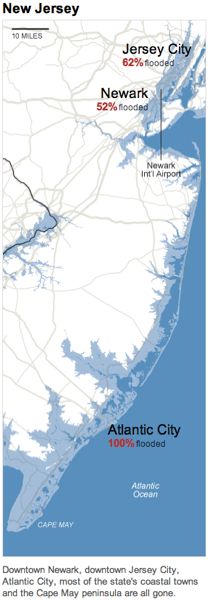Downtown Newark, downtown Jersey City, Atlantic City, most of the state’s coastal towns and the Cape May peninsula are all gone.
Above map is from the Nov. 24, 2012 NY Times.
Below excerpts are from a 2005 Princeton University Study: FUTURE SEA LEVEL RISE AND THE NEW JERSEY COAST – Assessing Potential Impacts and Opportunities
Land use planning and building codes can play in important role in coastal hazard management. In New Jersey, and the U.S. at-large, there remains a significant lack of public understanding of the predictability of coastal hazards and hazard mitigation. Episodic flooding events due to storm surges are often perceived as ‘natural disasters’, not failures in land use planning and building code requirements. The presidential declaration of ‘federal disaster areas’ and the release of millions of dollars in state aid following major storm events may help foster the perception of storms as unpredictable ‘disasters’ resulting in unpreventable damage. Some property damage is unavoidable in the coastal zone from large storm systems, particularly along the oceanfront near a hurricane landfall. However, current research suggests that the total property damage related to coastal hazards is highly dependent on the design and elevation of the homes, buildings and other structures near the shoreline (Rogers and Tezak, 2004). […]
An important, and often underemphasized, strategy for decreasing the adaptation costs to sea level rise would be to decrease global greenhouse gas emissions. The release of anthropogenic greenhouse gases, notably CO2, exacerbates global warming which accelerates the rate of sea level rise. Several studies have attempted to determine response of sea level rise to different greenhouse gas emission scenarios (Wigley, 1995; Smith et al., 2000; Nicholls and Lowe, 2004; Wigley, 2005). Although substantial quantitative uncertainties exist in this research, and the uncertainties increase with time, the general modeled trends provide valuable insight. […]
Management programs focused on protecting the current shoreline will likely lead to the elimination of wetlands and natural beaches in most developed regions (Titus et al., 1988; Titus et al., 1991; Titus, 2000). New Jersey’s Garden State Preservation Trust Act provides the statutory framework and funding base needed to implement a plan for purchasing threatened wetland areas and undeveloped buffers between wetlands and development. However, most coastal wetlands are privately owned and the government can only protect a minority through an acquisition program (Titus, 1991; McCrery and Adams, 1995; Titus, 2000). It is more likely that significant portions could be protected through the implementation of a regulatory program requiring the gradual withdrawal of development from the coast. Policies, such as rolling easements, focused specifically at the preservation of coastal ecosystems could prove useful. If future coastal management policies do not accommodate the natural inland migration of beaches and wetlands, these natural systems may disappear beneath the rising sea and the ecological, economic, and social benefits they provide will be lost.


certainly like your website but you have to
test the spelling on quite a few of your posts. A number
of them are rife with spelling issues and I to find it very bothersome to inform the truth on the
other hand I’ll definitely come back again.